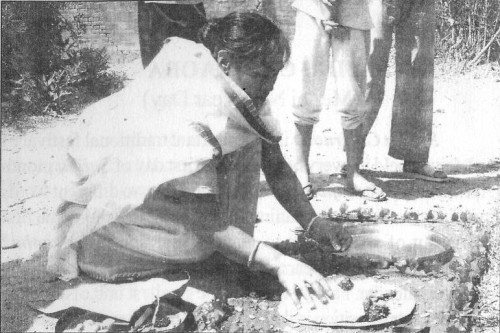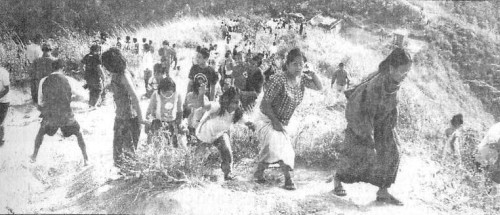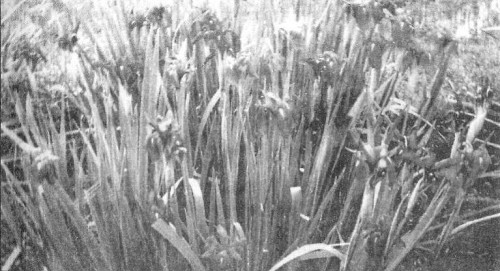Sajibu Cheiraoba
( Meitei New Year Day )
By: N Mangi Devi *
Sajibu Cheiraoba is an important traditional festival of the Meiteis held in every house on the first day of Sajibu month (April) every year.
Sajibu and Cheiraoba are two different words implying two different meanings :- "Sajibu" indicating the first season out of six seasons to make a year and "Cheiraoba" indicating the end of the year and beginning of a new year according to Meitei calender.
Family which is the smallest unit of a society holds the central position in the celebration to bring peace, harmony and prosperity for the family. It touches on all aspects of life with its essence be it the body mind, spiritual, social and emotional desires.
Preliminary works for the celebration are done well ahead of the day of the festival. Such as the cleaning of the house and furniture even utensils of the kitchen and shopping for purchases of new cloths for parents, brother and sisters etc.
 |
| Offering of cooked foods to Hanu Kokchao and Hanu Leikham (the guarding dieties) at the gate of every house on Cheiraoba |
|
The ceremonial part starts early in the morning. The women of every house prepare Athelpot containing fine whole rice, raw vegetables of different kinds, fruits and flowers of the new season. Athelpot is meant for offering to Lainingthou Sanamahi and Leimarel Ima Sidabi at the altars placed on southwestern corner and middle north corner of the house respectively.
Prayers are made by all the members of the family. After it the offered foodstuffs such as rice and vegetables etc. will be cooked and made different varieties of dishes by female members of the family.
Then the cooked food will be placed on nicely round-cut plantain leaves and offer to Emoinu Ima at the fire place of home and the same food will also be offered at the gate of the house to the god spirits known as Hanu-Kokchao and Hanu Leikham with a prayer not to disturb the happiness and to defend the family from sorrows and difficulties during the whole coming year.
After finishing these offerings all the members ofthe family will dine together in a pleasing mood and making jokes merrily to each others. Varieties of foods are also shared with the neighbours to get different tastes of different families. Every one in each and every family enjoy taking the choicest food.
At evening people of both genders male and female, young and old and children put on fine dress and climb nearby hills where they worship the gods and goddesses of the locality, sometimes Siva-Durga, Panthoibi etc. Younger people mainly married women go to their parents at the evening and offer new clothes to their parents, brothers and sisters and seek their blessings. Thus they revere their elders with love and respect. This is a social event with a motive of love and unity.
 |
| Climbing of Cheiraoching (Hills) after the grand feast on the day of Cheiraoba |
|
In Manipur Sajibu Cheiraoba is observed on two different days,
(i) Sajibu Nongma Panba - the first day of Sajibu by traditional Sanamahi Laininglup
(ii) on the day of Charak Puja of Bengal which was introduced by Bhagyachandra Maharaja (1760 A.D. Saka year 1682). But the system and method of observation are the same to both sections of the society. The first one is following lunar year and the later is of the solar year from the astrological point of view.
Significance of Sajibu Cheiraoba - It is believed that on the first day of Sajibu month (April) the cosmic Universal God -Sidaba Lainingthou Sanamahi (Immortal Almighly) stays sitting on the atlar of the house (south west corner) waiting for the offerings from his devotees. This day is a rare and most sacred day of the year for on this day the honest devotees of Lainingthou Sanamahi of seven yeksalais (clans) of Kangleipak do offer different varieties ofvegetables, fruits and flowers of the new season to Sanamahi, Laimaren Ima and Imoinu Ima and other spirits of the land and pray for the welfare of the coming year and seek the grace of Almighty God.
Thus every house arranges grand feast that are shared with their neighbours. During this month all seeds sown in the previous month of Lamda, (March) sprouted buds of the seedlings are coming out to yield natural shape and colour. Analogically seeds of nine kind of species say human beings, animals, fishes, insects, mosquitoes, trees, bamboos, pulses and plants have sprouted and shown their heads like horns of saji(deer) as designed by Almighty God as saji (deer) changes its horn. That is why the great significance of the first day of Sajibu month that people can enjoy life to the full as the nature expresses herself with a calm weather and plenty.
 |
Beautiful blue flower "Komberei" (Eupatarium Odaratum)
The flower that form part of the celebration of Cheiraoba |
|
Cheitharol Kumbaba (Royal Chronicles) - Reign of Meidingu Lairen Naophangba say 428-518 B.C. Cheiraoba - Indication of end of the year and beginning of a new year. A responsible king's servant riding a horse binding a bell and flag on a wooden pole giving the message on the streets and celebration of happiness of new year so called "Sajibu Cheiraoba" In the book " Kanglei Ningou Chahi"- Message from Pana-Mari-Four sides - Khurai, Khwai, Wangkhei and Yaiskul, the men wearing different clothes of different Panas riding the horse tiding bell on the pole shouting in the same manner the end of year and beginning of new year as " Sajibu Lakyel Taiba". In the "Bijay Panchali" 2nd Khanda saji (animal deer) changes their horns in this month of Sajibu (April) During the reign of
Meidingu Khyamba in 1467-1508 the way of giving message by riding the horse and shouting in the streets have stopped and it became known as "Cheithaba" -The king selected a person who takes an oath on that day of Sajibu to accept all the burdens of the king and his subjects that are to be fallen in the coming year. The first named "Cheithaba" is called "Hiyangloi".
From this year onwards a book started to write named as "Cheitharol Kumbaba" and such Cheithaba had been honoured by putting his name in the horoscope of every child born during the year. In this manner though the name has been changed as "Cheiraoba" the celebration and festival have still been performing. In early days the Cheithaba had been given award of cloth, one pari of paddy field and exempted from other duties of the state. During the reign of Sir Churachand Maharaja instead of awards and others the "Cheithaba" was given Rs. 10,000 and since then no record for such monetary award is known.
Sajibu month is so important from the religious point of view. It is the first month of the year according to Meitei Calender. On the 7th day a very important ritual ceremony known as Kongba LeithongPhatpa, Sajibu Leikhun Phunba has been performed at the places known as Ningthem Pokpa and Angom Pokpa located on the eastern bank of Kongba river where it meets Ml river. What is it and how does it ?
From these places better known as LAIPHAM whatever available may be anything like metal piece or insects when the ground is dug out and is wraped in a new cloth and tied them. The Maiba will bring it putting round his neck and keeps it on an earthern jar for 5 days at YUMJAO LAIREMBI'S place with a prayer. On the basis of whatever available when it is opened the MAICHOU and other intellectuals forcast good or bad of the agricultural products of the coming year.
This is written in Kanglei Ningou Chaibi and Sajibu Cheiraoba, such ritual ceremony had been started from the time of Nongda Lairen Pakhangba. In this month of Sajibu people make agricultural land by levelling the uneven ground of paddy fields and kitchen gardening areas and prepare different grounds for cultivation of the coming year. People plough their fields, prepare the soils and make ready for cultivation.
* N Mangi Devi wrote this book entitled "Festival of Manipur" .
This article was webcasted on January 21st 2010.
